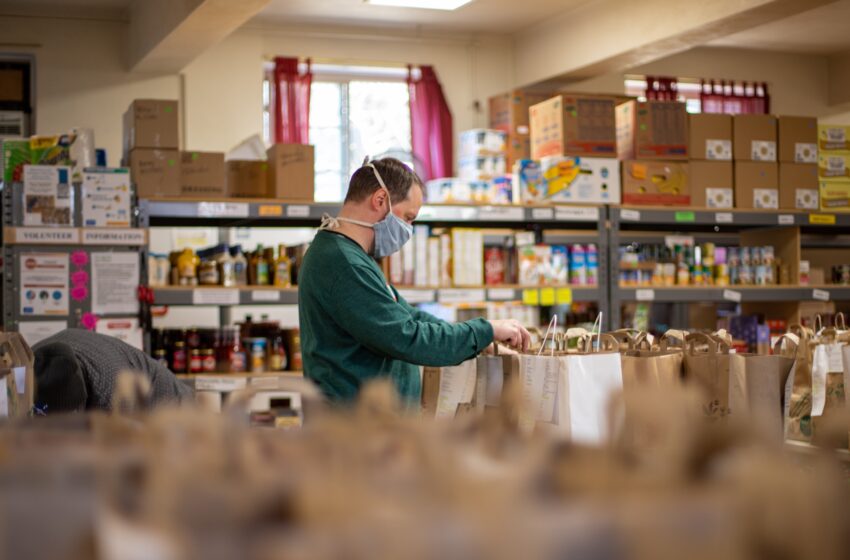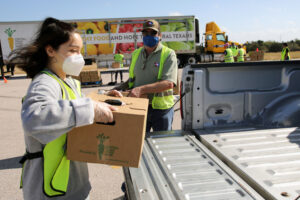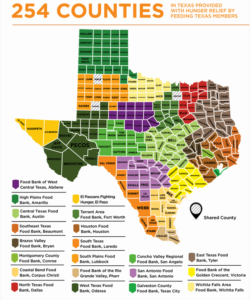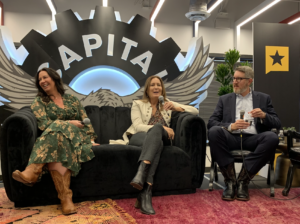Ending the Line

Feeding Texas CEO Celia Cole speaks to the challenges of addressing hunger for food-insecure Texans.
Most Texans remember the long lines at food banks at the height of the pandemic. If they weren’t in them, they would have seen them on the news. While those images were stark and startling, they also represented a pivot in delivery, according to Feeding Texas CEO Celia Cole. 
Today one in eight Texans is food insecure. That’s about 13 percent of the state’s population. To help bridge the hunger gap, the state’s largest hunger-relief organization, Feeding Texas, supports 21 member food banks across Texas’ 254 counties and provides some five million Texans each year with food and resources.
As a part of our fourth quarter focus on the business of feeding Texas, we talked to Cole about the current hunger need, how it’s being met, and what the Feeding Texas network is doing to bring about the end of the line.
What have the last three years at Feeding Texas been like with the pandemic? How did it affect food insecurity and what factors helped or hindered your efforts?
There are a lot of overused metaphors out there for what we’ve been experiencing the last few years. It’s hard to choose. I would say it’s like nonstop drinking from a fire hose. On March 13th, little over two and a half years ago now, when the first shelter-in-place order came out, we had a network call with the 21 food banks in our network. I remember saying to one of my coworkers, “Well, we’ll set these up to be weekly calls, but I don’t think we’ll need them for that long.” I always look back on that comment and realize how wrong we were.
Food banks are no strangers to disaster. They’re nimble. We have decades of experience responding to disasters and other crises and navigating supply chain challenges. We fight the daily disaster of poverty, but COVID hit everywhere and everyone, and it hit us hard and forced us to adapt in ways that we hadn’t before. So, on the one hand, you had people experiencing massive job loss; you had parents affected by school closures. You had people sick obviously. And really, food insecurity almost doubled overnight. So it was that immediate impact that we hadn’t experienced before of having to ramp up that quickly.
Then on the food bank side of things, we lost a lot of our volunteers. In fact, in some areas, we lost 80 percent of our volunteer base. Then we lost a lot of the partners; a lot of the partners that help us get food out to the communities also had to shut down. A lot of these are churches and other smaller nonprofits that themselves are volunteer staffed, often senior volunteers, and it wasn’t safe for them to stay open.
So our whole distribution network was uprooted, and of course, our own staff was affected as well. We had people who were sick or who were immunocompromised and had to take extra special care not to catch COVID. So we had to reinvent how we operate, how we work without volunteers. Food banks pivoted from going through this pantry network to get food to people to these mega direct distributions. You may have probably seen the pictures of long lines at the Alamo Dome and in parking lots. Some food banks served thousands of families a day in a kind of drive-through situation.
So, that was really challenging, and we had to completely pivot in how we reach people. Then of course, it kept going. Like I said, sort of nonstop drinking from a fire hose.
How are things now, two and a half years later and businesses are opening back up. Is it getting back to normal or are you still struggling with some of those same challenges?
When I think about the people we serve, the main challenge I think they’re struggling with right now is just inflation and the high cost of living, and in particular the food costs have really shot up. We have not experienced that much of a drop-off in terms of the demand. If you look back to pre-pandemic—let’s say we look back to 2019—we’re serving still more people than we served in 2019. There was a little bit of a drop-off from 2020 to 2021, but we are still serving one-third more people than we were prior to the pandemic.
That’s a reflection of two things. One, it takes people a lot of time—people who are at the lower end of the economic ladder and living hand-to-mouth, paycheck-to-paycheck before a crisis hits—it takes them a lot longer to dig out after the crisis. They don’t have the same kind of personal safety net or assets that they can rely on to weather those bad times. So even when you see economies rebound and even during really good economic times, you don’t see those people at the lower end of the economic ladder experiencing those benefits. They’re still struggling, and then on top of that, you’ve got really high inflation and the high cost of food and rent. That’s leading more and more people to our food banks for help.
How has inflation affected what you do? How has it affected your ability to get food contributions to feed people?
It’s definitely affected fundraising and particularly funds that we used to get from individuals. The food banks are involved in fundraising year-round, in good times and in bad. Where we’ve seen greater challenges is in individual giving because there’s so much uncertainty out there. People are worried.
On the food side, we’re receiving a lot less USDA product than we were back in 2019. That’s really a huge source of the food that we provide. Figuring out, “How do we continue to meet this increased demand with so much less food coming in?” has been challenging as well.
During the pandemic, we had a lot of support from individual donors, high donors, for example the McKenzie Scott donations. We had a lot of corporate support. So we really are very grateful for the generous outpouring of support from our donors and our supporters during the pandemic. That helped food banks, and what we’re seeing now is food banks having to take more of those donations that they might have otherwise put into operations and expanding services and things like that to buy food. That’s fairly new for food banks. Our model isn’t going out and buying food at market prices, but [along] with the significant drop off in USDA foods, individual donations of food have gone down as well. The retail donations have stayed fairly constant. So food banks are having to really dig into their stores in order to buy food to be able to meet the ongoing need. And that’ s, again, fairly new for us.

You mentioned the USDA, are the foods you receive part of the Supplemental Nutrition Assistance Program (SNAP) or is that different?
It’s different. The USDA also administers the SNAP program, but the program that supports food banks is called TEFAP, or The Emergency Food Assistance Program. It’s always been a big source of food for food banks and other charity food providers. Basically, the USDA buys up surplus ag product in order to subsidize agriculture in the United States, and then makes those surplus commodities available for hunger relief. Those products go to food banks essentially through our state Department of Ag. Before the pandemic, it was probably a quarter—or several years before the pandemic—it was probably a quarter of all food that food banks distributed, and then that increased.
Then of course, during the pandemic, it made up about 50 percent. So it’s always been a really critical source of really nutritious foods. We’ve seen a drop off there, so if you compare the amount of USDA product that we’re forecasting to get this year, and you compare that to 2021, we’re going to get 45 percent less USDA product than we did in 2021. So that’s concerning. The good news is USDA recently announced $1.5B in new support for charitable hunger relief, and we expect to start seeing that product in the spring of 2023.
SNAP benefits have really been critical to helping families get by because SNAP is really the backbone of our nation’s defense against hunger. You’ll often hear food banks say. “We’re not going to food bank our way out of hunger.” What that means is that we’re one piece of a much bigger anti-hunger ecosystem, and SNAP is really the biggest piece of the system.
So how many Texans do you currently have the capacity to feed through your food bank network, roughly?
That’s a really difficult question to answer for a couple of reasons. Obviously, food banks measure their capacity in terms of how many meals they provide, how many pounds of food, how many people served, but that doesn’t really answer the question we really want to know, which is: Are we meeting the need in our communities? Are we reaching people equitably? Are we getting into all those areas where there’s the greatest need? Are we providing the right kind and amount of food? Is it nutritious? Is it culturally relevant? Is it enough to meet nutritional needs?
Having better data and better insights into the needs of people experiencing food insecurity is really critical. We’re working with our national network, Feeding America, to really hone the tools we need to gain those insights. That’ll give us a more complete picture of the need and really help us determine the role of food banks in meeting that need.
So, like I said, we’re not going to food bank our way out of hunger. Food banks were really established to fill the gaps and not be a year-round source of food for every Texan experiencing food insecurity. When we have that better picture of what people who are experiencing food insecurity really need—What are some of those root cause issues?—we’ll know how better to fill those gaps, but at the same time, we’ll need to continue to strengthen the federal nutrition safety net including SNAP and the child and senior nutrition programs.
Which areas geographically are, or if there are any, of Texas hardest hit by food insecurity? Does it fall in line with your metros? Or is there a geographical component?
It tracks poverty. So where you have higher levels of poverty, you’re always going to see higher levels of food insecurity. It’s not a food problem. It’s a money problem more than anything, but certainly in terms of their causes, in urban areas, it might be the high cost of living and high cost of childcare and other things compared to really low wages. Then you have rural poverty, which is a different problem, where it’s more about joblessness and lack of infrastructure and other types of services or lack of transportation to get to jobs or services. You see it more prevalent in these highly dense urban areas but just as equally prevalent in these really rural areas, and Texas is a very rural state.

Your website cites populations of people who suffer more from food insecurity than others. Which ones would you say have a higher prevalence in food insecurity, and how does Feeding Texas address that margin?
The people who are hardest hit are people of color. In the latest data that has come out, about one in eight Texans overall are facing food insecurity. When you break that down by race and ethnicity, those numbers are even more stark. So one in four black Texans and one in five Latino Texans are facing food insecurity compared to one in 14 white Texans. So it is definitely people of color who are disproportionately impacted by hunger.
If you look demographically, it’s children and seniors. Anyone who’s a member of a historically targeted group, including the LGBTQ community, they’re more likely to suffer from food insecurity. Then also people who are living with disabilities or chronically ill who may struggle to work, they’re also more likely to experience hunger.
We’re really focused on figuring out, are we reaching communities equitably? If black and brown communities are more likely to be struggling with hunger, what can we do to make sure that we are getting food to those communities and really working with organizations serving those populations to understand their needs and figure out what is the best way to reach them?
We rely so heavily on having partners to get food to people. It’s always been difficult to reach those more isolated and remote areas of the state, so looking at innovative ways to reach people, mobile feeding, taking a food truck into the community rather than sending food to that community. We have emerging partnerships with places like Amazon and Favor and Uber to try and help us get food directly to families—so household delivery, which is not something, again, food banks have done a lot in the past. It’s typically been people coming to a food site. So now we’re figuring out, can we do home delivery? That was particularly important during COVID when there were so many home-bound people.
One of the most significant infusion of resources came from the Texas legislature. Last year, they invested $95 million of the American Rescue Plan Act funds that came to Texas in food banks, in helping food banks build their capacity to reach those underserved areas and those populations that are disproportionately impacted by hunger. So that investment is helping food banks build up the capacity and the distribution networks to get to those communities, looking for new partnerships, setting up satellite sites in areas where we have no partners, investing in those mobile feeding strategies.
Having been in your role now for a little over 10 years at Feeding Texas, how has the need for hunger relief grown or decreased in that time?
It ebbs and flows, and when the economy gets worse, food insecurity gets worse. We saw that during COVID, but I think the really telling time, like I mentioned earlier, is during those good economic times, when you would think that it would go down and it just doesn’t. Again, that has to do with the fact that the cost of living has outpaced the increase in wages. It’s become harder to get by in this country. People are more worried about their ability to get by, and not just get by but also put kids through college and save for the future.
It’s discouraging to say, “Oh well, I’ve been here 10 years, and we haven’t seen much difference.” That’s not to say that food banks haven’t done an incredible job pivoting to be able to meet the increased need, and really, during COVID figuring out how to reinvent themselves.
What are some of the best strategies that you’ve found that have worked for you to pivot?
Some of it is just the nature of food-banking. They’re used to it. We deal with this daily disaster of poverty, so we’re constantly dealing with families in crisis. We can move quickly, and if the need shifts from one area to another or one population to another, food banks are really masters of logistics. They’re good at getting the right food to the right people at the right time. So when that changes, those variables change, they have a lot of expertise and experience and deep knowledge of their communities, and that helps them to do that pivot.
The big challenge has been building the capacity to do that. So, even when the food is free or donated, there’s a cost associated with the building’s need to store that food and the refrigeration, and the transportation to get food to people, the labor, the people that we need, the truck drivers—all of that. The ways in which we’ve grown over the years as the need has grown is directly related to food banks looking ahead and saying, “What is the capacity we’re going to need?” It’s like this constant capital campaign of figuring out how we need to expand our footprint and where in order to keep up with the need.
Right now, what’s the most challenging business aspect at Feeding Texas?
It’s dealing with that uncertainty: the constant fundraising and making sure that we’re going to be able to bring in both the financial and the food resources that we need to reach people. The high degree of political polarization is challenging. We always have thought of hunger as this completely nonpartisan issue. Doesn’t matter what side of the aisle you’re on, nobody wants to see a kid go to school hungry or a senior forced to choose between eating and their medicine. But everything is so polarized right now, and that’s making it more challenging for us to do our work.
In 2012, the contributions and donations and revenue totaled 5.3 million. In 2021, it was 40.2. What do you attribute that kind of growth to? That seems significant.
It isn’t an apples-to-apples comparison. First of all, most of the funding that you see in our budget flows to food banks. But our staff at Feeding Texas has certainly grown. When I took over, we had a staff of seven, and now we have this fabulous staff of 22 people. So we’ve grown, but most of the growth in our budget is a result of bringing in additional resources, usually food resources, that go directly out to food banks.
The reason I said it’s not apples to apples is that every time there’s a major disaster, our budget increases significantly. So, what you’re seeing now is the result of several one-time federal grants, food grants that we’re administering in order to help food banks meet the increased need.
So it’s really, it’s not a reflection of fundraising, hitting the streets, talking to people. It’s a reflection of spikes in need for different things.
Yes. What worries you, what keeps you up at night, that sort of uncertainty is just the lack of control we have over the work we do. We’re not a business that is able to always control all the different variables that go into growth, and so we don’t always know when we’re suddenly going to see this increase in need. It’s hard to plan for.
Just like the food banks, we have to pivot and expand in order to be able to manage those additional resources. But again, 80 percent, 90 percent of the funding flows through to the food banks, and it’s mostly for food assistance. But we also manage several statewide programs that provide resources to food banks to help people apply for SNAP and to provide nutrition education and wraparound services like that.
Anytime a disaster happens, it affects how your contributions work. Aside from feeding people directly, it looks like there are other things you do at Feeding Texas, initiatives, if you will. Disaster relief is one when you step in, and public policy. From the outside looking in, it looks like you take this holistic approach to what you do. Can you talk about that a little bit? Why is it so important to have that kind of approach?
It goes back to something I said earlier, which is, “we can’t food bank our way out of hunger.” We know that we’re one part of the solution, and again, when people go hungry, it’s not as much about lack of food. It’s about lack of resources, so we need to step back and look at what we can do to prevent someone from going hungry in the first place. What can we do to address those root causes that lead people to need our help? It’s really about shortening the line as much as it is about feeding the line. Then finally, it’s about ending the line. That’s where some of the more systemic solutions come in around ensuring that work pays and people can make ends meet on their own, that the jobs are paying enough wages to help people not just get by but also save for the future and that people have access to quality healthcare and childcare and all of the things that go into economic security.
The primary mission of food banks is charitable food assistance; it’s meeting that emergency, that immediate need of getting food to people. But then it’s also figuring out what the policies are that need to be in place, whether there are more systemic changes that need to happen to really get at those root causes. That’s where Feeding Texas really comes in, and we’ve built up our staff to be able to communicate with policymakers, make the case with policymakers for change, and then directly advocate with elected officials for programs like SNAP. But also again, it’s not just food; it’s money, making sure that people have adequate wages and access to health insurance and things like that. So really, it’s about feeding the line, shortening the line, ending the line, and we have really built our new strategic plan around that more holistic approach to addressing hunger.
What’s the bright spot right now at Feeding Texas? What’s exciting right now?
Personally, I’ll start with my team. I’m really proud of them. We’ve grown a lot over the years, not just in numbers but also in scope and in expertise. So I have a really fabulous group of mission driven people working for me right now.
The second thing I would say is we’ve spent the better part of last year working with our network to build a new strategic plan to focus on where we are going to have the greatest impact in the years to come for the people we serve. And I feel like we have a really high degree of alignment across our network right now, more so than we ever had before about not just where we need to be putting our focus and our resources, where we need to be innovating, but what each person’s role, what each organization’s role is in that.
So obviously Feeding Texas isn’t directly feeding people. Our food banks are doing that. But what are the contributions that Feeding Texas can make to support food banks in achieving their goals and having that impact for the communities they serve? We have an expression in the Feeding America network: We are better together. We are this group of unique, distinct nonprofits, 21 different nonprofits with different boards of directors, serving very different areas of the state. But really, and a lot of our strength comes from being unique and local and each food bank really understanding the needs of their communities, but our strength also comes from our ability to act as one, to speak as one.
We are in a better position than we ever have been to do that. Some of that is a result of the crisis, the drinking from a firehose. We’ve been doing that together for three years now, and I think our network is sometimes at its best when things are at their worst. It’s like that when the going gets tough, the tough gets going. So when I look at our network and I look at my team, I feel really optimistic about what we can accomplish together and maybe less optimistic about the state of affairs around us.

Is there anything else you’d like to add to our conversation about the business of what you do?
One of the things people don’t often realize when they think about food banks is just what a large scale, sophisticated operation they are. People often think of these little dusty warehouses and stacks of canned goods. Food banks are much more; they operate much more like businesses than people think.
The other thing I would say is that fighting hunger is really a public-private partnership. So speaking to the business community, their support—and it’s not just their dollar support but their engagement in what we do and their willingness to thought-partner with food banks and with Feeding Texas—they have capital, which we don’t always have. So the support of the business community—but again not just financial—is really critical.
The last thing I wanted to mention, we talked about how food banks have built capacity, how they’ve grown to meet the need, and really looking ahead to see where the food sources are most likely to come from is very important to what we do. One channel that is growing (and food banks have done a really good job capturing more of it) is produce, fresh produce.
Texas is one of the biggest ag states in the country, and there’s an abundance of produce that’s grown that can’t make it to market for whatever reason. We have a regional initiative right now called the Collaborative for Fresh Produce, to work directly with growers to capture some of that surplus and get it out to our networks. It’s kind of that win, win, win. It helps growers who need an outlet for that surplus, otherwise it would cost them to sell it under or dispose of it. It gets really nutritious food to people because produce is one of the top components of health. Environmentally, it has a win in that it leads to less food in the landfill. That’s a great example of a public-private partnership.


